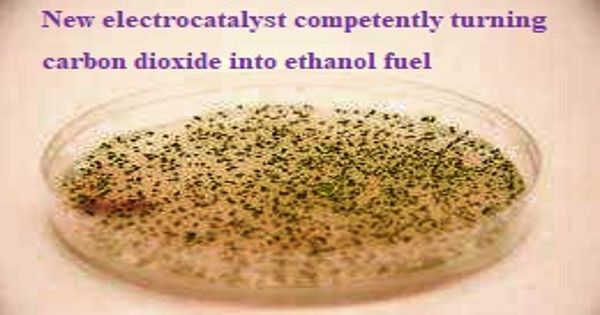New electrocatalyst competently turning carbon dioxide into ethanol fuel
US researchers have discovered a new electrocatalyst that transforms carbon dioxide (CO2) and water to ethanol with very high energy efficiency, high selectivity for the target end product, and low cost. Catalysts accelerate chemical reactions and form the basis of many manufacturing processes. They are important, for example, in refining heavy oil into petrol or jet fuel. Nowadays, catalysts are involved in more than 80 percent of all processed goods. The key is an electrified copper and carbon catalyst that researchers believe can be powered by low-cost off-peak or renewable energy.
The Department of Energy (DOE) Argonne National Laboratory, in cooperation with Northern Illinois University, has discovered a new electrocatalyst that transforms carbon dioxide (CO2) and water into ethanol with very high energy efficiency, high selectivity for the target end product, and low cost. Ethanol is a highly valuable product since it is an ingredient in virtually all U.S. fuel and is commonly used as an additive in the chemical, pharmaceutical, and cosmetics industries.
Scientists have invented a new method for turning carbon dioxide into a liquid fuel that can efficiently store energy in fuel cells.
US researchers have discovered a new electrocatalyst that transforms carbon dioxide (CO2) and water to ethanol with very high energy efficiency, high selectivity for the target end product, and low cost. Northern Illinois University professor and participating Argonne researcher Tao Xu says the current catalyst is not just a single stop that can generate ethanol—it’s the first step on a possibly long list of ways to turn carbon dioxide into other valuable chemicals.
“The process resulting from our catalyst would contribute to the circular carbon economy, which entails the reuse of carbon dioxide,” said Di-Jia Liu, a senior chemist at the Chemical Sciences and Engineering Division of Argonne and UChicago CASE scientist at the Pritzker School of Molecular Engineering, University of Chicago. This can be achieved by turning the CO2 produced from manufacturing operations, such as fossil fuel plants or alcohol fermentation plants, into useful goods at a fair rate.
The team’s catalyst consists of nuclearly scattered copper backed by carbon-powder. This catalyst breaks down CO2 and water molecules through electrochemical reactions and selectively reassembles fragmented molecules into ethanol under an external electrical field. Electrocatalytic selectivity, or “Faradaic efficiency,” of the process is more than 90%, much higher than any other process published. In addition, the catalyst operates steadily over sustained service at low voltage.
“With this research, we’ve discovered a new catalytic mechanism for converting carbon dioxide and water into ethanol,” said Tao Xu, Professor of Physical Chemistry and Nanotechnology at Northern Illinois University. “The mechanism should also provide a foundation for the development of highly efficient electrocatalysts for carbon dioxide conversion to a vast array of value-added chemicals.”
Since CO2 is a stable molecule, turning it into another molecule is typically energy consuming and expensive. However, according to Liu, “We could couple the electrochemical process of CO2-to-ethanol conversion using our catalyst to the electric grid and take advantage of the low-cost electricity available from renewable sources like solar and wind during off-peak hours.” Since the process works at low temperatures and at low pressure, it can start and stop rapidly in response to the erratic supply of electricity.
The research team benefited from two DOE Office of Science Consumer Facilities in Argonne—Advanced Photon Source (APS) and Center for Nanoscale Materials (CNM)—as well as Argonne’s Laboratory Computer Resource Centre (LCRC). “We have captured the structural changes of the catalyst during the electrochemical reaction thanks to the high photon flux of the X-ray beams at the APS,” said Tao Li, an assistant professor in the Department of Chemistry and Biochemistry at the University of Northern Illinois and an assistant scientist in the X-ray Research division of Argonne.
The research team benefited from the Advanced Photon Supply (APS) and Center for Nanoscale Materials (CNM) of the DOE Office of Science Customer Facilities in Argonne and the Laboratory Device Resource Centre of Argonne (LCRC). Tao Li, an assistant professor in the Department of Chemistry and Biochemistry at the University of Northern Illinois and an assistant scientist in the X-ray Research Division of Argonne, said, “We have captured the structural changes of the catalyst during the electrochemical reaction thanks to the high photon flux of the X-ray beams at the APS,” These data, along with the high-resolution electron microscopy at C.















